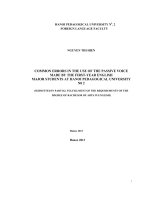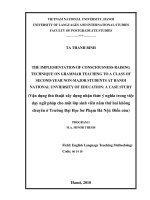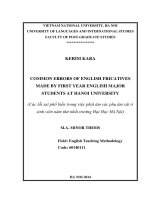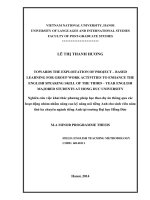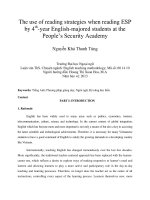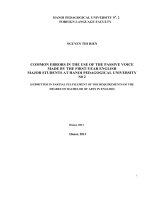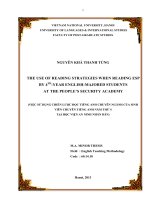The effectiveness of using graded readers as extensive reading materials by second year english majored students at hanoi pedagogical university 2
Bạn đang xem bản rút gọn của tài liệu. Xem và tải ngay bản đầy đủ của tài liệu tại đây (637.93 KB, 66 trang )
HANOI PEDAGOGICAL UNIVERSITY 2
FOREIGN LANGUAGE FACULTY
ĐÀO THỊ DIỄM
THE EFFECTIVENESS OF USING GRADED
READERS AS EXTENSIVE READING MATERIALS
BY SECOND YEAR ENGLISH MAJORED STUDENTS
AT HANOI PEDAGOGICAL UNIVERSITY 2
(SUBMITTED IN PARTIAL FULFILMENT OF THE REQUIREMENT
OF THE DEGREE OF BACHELOR OF ARTS IN ENGLISH)
B.A THESIS IN ENGLISH
SUPERVISOR: DO THI THANH DUNG
HA NOI, 2017
ACKNOWLEDGEMENTS
I would like to express my sincere gratitude to my supervisor, Do Thi
Thanh Dung for her unwavering patience, guidance and support throughout the
semesters, without whom this project would not have been completed. I would
like to thank all the lecturers for their guidance and advice.
I would also like to thank students for the cooperation given for the
research. I am also grateful to my family and friends who gave me the courage,
support and assistance throughout my course.
A final note of heartfelt gratitude to for their loving support, patience and
encouragement which made it possible for me to sail the boat smoothly
throughout this amazing and educational journey.
Last but not least, I would like to thank my parents who taught me the
value of education.
i
ABSTRACT
This current study investigates the impact of graded readers on student‟s
reading skills. The study in detail explores the effectiveness of graded readers by
seeking to answer if it helps to promote comprehension and positive attitude
among students precisely in reading. The study is based on comprehensible
input theory where students were engaged in large quantity of reading to achieve
better comprehension and enhanced reading speed with positive attitude. The
sample in this study consisted of four students of K41B English Language
Teaching Education, who are of intermediate level. The graded readers
programme was conducted for seven weeks. The results of the data analysis
indicated that graded readers helped to improve the reading comprehension and
reading speed mong the students. This was proven in terms of the marks
obtained in the post-test. Graded readers have also helped to promote positive
attitude toward reading which was seen through the descriptive analysis of the
attitude interview.
ii
STATEMENT OF AUTHORSHIP
Title:
THE EFFECTIVENESS OF USING GRADED READERS AS
EXTENSIVE READING MATERIALS BY SECOND YEAR ENGLISH
MAJORED STUDENTS AT HANOI PEDAGOGICAL UNIVERSITY 2
(Graduation paper submitted in particular fulfilment of the Degree of
Bachelor of Pedagogy in English)
I certify that no part of the above report has been copied from any other
person‟s work without acknowledgements and that the report is originally by me
under instructions of my supervisor.
Date submitted: April 2017
Student
Supervisor
Dao Thi Diem
Do Thi Thanh Dung
iii
LIST OF ABBREVIATIONS
FLF
Foreign Language Faculty
HPU2
Hanoi Pedagogical University 2
L
Level
P
Page
wpm
word per minute
iv
TABLE OF CONTENTS
ACKNOWLEDGEMENTS ................................................................................... i
ABSTRACT .......................................................................................................... ii
STATEMENT OF AUTHORSHIP...................................................................... iii
LIST OF ABBREVIATIONS .............................................................................. iv
TABLE OF CONTENTS ...................................................................................... v
LIST OF TABLES AND FIGURES ................................................................... vii
PART ONE. INTRODUCTION ........................................................................ 8
I. RATIONALE.................................................................................................. 8
II. OBJECTIVES OF THE RESEARCH......................................................... 10
III. SCOPE OF THE STUDY .......................................................................... 10
IV. RESEARCH QUESTIONS ....................................................................... 10
V. METHODS OF THE STUDY .................................................................... 11
VI. SIGNIFICANCE OF THE STUDY .......................................................... 11
VII. DESIGN OF THE STUDY ...................................................................... 12
PART TWO. DEVELOPMENT ...................................................................... 13
CHAPTER ONE. LITERATURE REVIEW ...................................................... 13
I.1. Teaching reading comprehension .............................................................. 13
I.2. Reading Speed ........................................................................................... 14
I.3. Reading and Vocabulary............................................................................ 16
I.4. Reading and Other Language Competences .............................................. 17
I.5. Extensive reading....................................................................................... 18
I.5.1. Authentic Material ............................................................................... 22
I.5.2. Created Material .................................................................................. 23
I.5.3. Graded readers ..................................................................................... 23
CHAPTER TWO. METHODOLOGY ............................................................... 26
II.1 Participants ................................................................................................ 27
II.2. Graded readers project.............................................................................. 28
II.3. Data collection instruments ...................................................................... 30
v
II.3.1. Interview............................................................................................. 30
II.3.2. Tests.................................................................................................... 32
II.3.2.1. Classification test ......................................................................... 32
II.3.2.2. Comprehension test ...................................................................... 33
II.3.3. Reading Speed Reports ...................................................................... 34
II.4. Data Analysis Methods ............................................................................ 35
II.5. Data Collection and Analysis Procedure.................................................. 36
CHAPTER THREE. FINDINGS AND DISCUSSION...................................... 38
III.1. Results ..................................................................................................... 38
III.1.1. Finding of the tests ............................................................................ 38
III.1.1.1. Pre-test and post-test ................................................................... 38
III.1.1.2. Reading comprehension ............................................................. 39
III.1.1.3. Reading speed ............................................................................. 40
III.1.2. Interview .......................................................................................... 42
III.1.2.1. Students‟ perspectives on reading skills ..................................... 42
III.1.2.2. Students‟ perspectives on graded readers ................................... 43
PART THREE. CONCLUSION ...................................................................... 49
I. Conclusion .................................................................................................... 49
II. Limitations and suggestions for further studies .......................................... 49
REFERENCES .................................................................................................. 51
APPENDIX A ..................................................................................................... 59
APPENDIX B ..................................................................................................... 60
APPENDIX C ..................................................................................................... 62
vi
LIST OF TABLES AND FIGURES
Table 1. Total New Words and Word Families at Each Oxford Bookworms
Level...................................................................................................... 26
Table 2. Grading System of the OBW Graded Readers ..................................... 27
Table 3. Description of participants .................................................................... 28
Table 4: Planning of graded reader project ........................................................ 28
Table 5: List of book title .................................................................................... 29
Table 6: Scores to evaluate level of graded readers ............................................ 33
Table 7: Results of pre-tests and post-tests ......................................................... 38
Table 8. Reading Speed of the participants at Level 3........................................ 41
Figure 1: Results of comprehension tests ........................................................... 39
Figure 2: Results of the reading speed Level 2 ................................................... 41
vii
PART ONE
INTRODUCTION
I. RATIONALE
There is no doubt that the role of English in the life of any society in the
world today has been becoming more and more important. The widespread need
for English as an international language puts a considerable pressure on the
education resources of any countries. In case of our country, since our
government carried out the open door policy to attract foreign investment and
co-operate with other countries, teaching and learning English has become
necessary. Moreover, it is the English that is used as an effective medium of
international communication. It is the language of trade, science, technology,
tourism, sport, music and many other fields of life. That is the reason why at
present, learning English is not only the interest but also the great and practical
demand for many people, especially for student who always want to assess the
modern world. Therefore, English is now taught as a compulsory subject to all
students at university in our country.
In many second or foreign language teaching situations, reading receives a
special focus. There are a number of reasons for this. First, many foreign
language students often have reading as one of their most important goals. They
want to be able to read for information and pleasure, for their career, and for
study purposes. In fact, in most EFL situations, the ability to read in a foreign
language is all that students ever want to acquire. Second, written texts serve
various
pedagogical
purposes.
Extensive
exposure
to
linguistically
comprehensible written texts can enhance the process of language acquisition.
Good reading texts also provide good models for writing and provide
opportunities to introduce new topics, to stimulate discussion and to study
language. Reading, then, is a skill which is highly valued by students and
teachers alike. In process of teaching and learning English as a foreign language
in Vietnam in general, and at Hanoi Pedagogical University 2 in particular,
8
reading has always been offered a great deal of attention both from the teachers
and the students. Like many others universities in Vietnam, English at HPU2 is
learnt and taught in non-native environment, therefore, reading is not only
considered as a means to gain knowledge but also a means by which further
study takes place. In other words, learners “read to learn” (Burns, 1988:11).
According to Carrel (1981:1), “for many students, reading is by far the most
important of the four skills in a second language, particularly in English as a
second or foreign language”. This is especially true to the students at HPU2,
where learners are mostly future interpreters, translators, or teachers of English,
whose desires are to be able to handle subjects related to written materials in
English and to work with their English-speaking colleagues and partners. It is
essential for them to acquire the ability to read English effectively and
efficiently.
However, despite the teachers‟ and students‟ effort, students still often
claim to have a lot of difficulties in reading English textbooks or English
materials, and therefore, they sometimes read them inefficiently. For the secondyear students of English, although they have been learning English for at least
several years, it is still often difficult for them to understand a text or a passage
in English, since they still lack vocabulary, grammar, reading skills and poor
background knowledge. When they encounter unfamiliar words or unfamiliar
concepts, they feel discouraged and resort to wild guessing to construct the text
meaning. Some students do not understand the main idea of a text even when
they have translated every word into their mother tongue. Almost students
deliberately look at the title of a text to think about its topic before reading.
Fewer
students
use
their
background
knowledge
to
facilitate
their
comprehension. They are completely dependent on the decoded messages from
the text. Many reading lessons makes the learners bored while taking part in the
reading process and their reading skills still keep stable. Besides, the teachers
sometimes have to face with difficulties in dealing with the students‟ learning
demand and newly introduced sources of materials.
9
To find out the areas of students‟ difficulty at the Hanoi pedagogical
university 2 and the causes of their unsuccessful reading comprehension is
necessary. These reasons have inspired the writing of a study on possible
effective reading activity as
“The effectiveness of using graded readers as extensive reading materials
by second year English majored students at Hanoi Pedagogical University 2”
It is hoped that the study will make some contributions to improve the
learning of English in general, and the learning of reading in particular among
the 2nd-year English majors at HPU2. The research hopes that it will be possible
to make suggestions for the teachers to improve the situation of teaching and
learning reading at Hanoi Pedagogical University 2.I ultimately wish the readers
to find something of relevant and practical use to their study and work with
English.
II. OBJECTIVES OF THE RESEARCH
This study aims to achieve the following objectives:
1. To find out the influence of using graded readers to the student‟s reading
comprehension.
2. To find out students‟ perspective on graded readers in reading.
III. SCOPE OF THE STUDY
The general research area of this study is graded readers in reading skills.
This study focused mainly on the effectiveness of using graded readers on
reading skills of sophomore students in Hanoi Pedagogical University 2 and
their attitude towards graded readers and reading skills in general.
IV. RESEARCH QUESTIONS
1. What is the effectiveness of using graded readers for second year English
learners in HPU2?
2. What are students‟ perspectives toward graded reader in reading?
10
V. METHODS OF THE STUDY
To obtain the results of this study, the following instruments are applied:
• Interview was designed to collect data about their general reading and
graded reader from the second year English Language Teaching Education at
HPU2.
• Tests for students ( Pre-test and post-test) : these tests help the researcher
to evaluate the improvement of students before and after using graded readers.
• Self-report: These reports were used to measure the student‟s speed of
reading in each graded reader book.
VI. SIGNIFICANCE OF THE STUDY
As mentioned earlier, attitude of students and commitment of teachers
could contribute to the lack of reading and based on these existing setbacks, I
was driven to conduct this study to see whether the graded readers could help
students to comprehend texts better and at the same time acquire better reading
speed. It was also conducted to see whether the graded reader programme could
change the students‟ attitude towards reading.
It is hoped that the students can gain a lot of benefits because graded reader
has given them opportunity to use or practice the language among their aged
group friends which is less stressful for the school, the findings of the study may
give significant pedagogical implications in implementing extensive reading
among the ESL learners.
This study can also provide some insights and suggestions to teachers as
well as students so that extensive reading can be emphasized as one of the
school language programmes especially in university. It is hoped that graded
reader can help and guide students to develop and improve their reading,
comprehension skill, speed of reading and at the same time, change their attitude
towards reading.
11
VII. DESIGN OF THE STUDY
The thesis consists of 3 parts.
Part 1: Introduction is a brief description of the research including the
reasons for choosing topic, scope, aims and methods of the study.
Part 2: This is the main part of the study which is divided into 4 chapters
Chapter 1: Introduction. This chapter explains the rationale for choosing
the topic and methodology, as well as the tasks and objectives.
Chapter 2: Literature Review presents theoretical background of the study
including reading comprehension and the influence of using graded readers in
learning and teaching the reading skills of a language.
Chapter 3: Methodology provides background information on the teaching
and learning situation and the methods and process of the study.
Chapter 4: Results and Discussions presents the findings on the application
of graded readers in teaching English reading.
12
PART TWO
DEVELOPMENT
CHAPTER ONE
LITERATURE REVIEW
I.1. Teaching reading comprehension
Thank to comprehension, reading becomes a useful and logical activity. A
main purpose of teaching reading comprehension is to motivate students to
develop the knowledge, skills and experiences, which help them become
enthusiastic and competent readers.
Reading is considered one of the most important skills that university
students of English as a Second Language need to acquire (Levine et al., 2010:
84). Reading is important not only in developing language intuition and
determining
academic
success, but
also
for completing certain task.
Therefore, it is obligatory for students, especially those who study in colleges to
have good reading skills. They should acquire such an ability that they can
easily handle any reference they need for accomplishing every task given
to them. In addition, it is avoidable that they will deal with accomplishing
writing academic paper which finally forced them to read various books and
references. In short, it is crucial for the students to acquire reading skill.
Acquiring reading skill requires one to be able to comprehend the text
itself. However, students often have difficulties in learning English as a foreign
language without appropriate learning materials. Too often foreign language
reading texts are designed either too difficult or too easy for students. Without
appropriate reading texts that suit them, students spend long hours in the
classroom with poor achievement. Students‟ performance varies according to the
type of reading texts given to them.
Regarding the problem stated above, Harmer (2007) argues that
getting students to read English texts is an important part of the English
13
teacher‟s job because of four reasons. First, many students want and need to be
able to read English texts for present study, for further study, for future career or
simply for pleasure. Second, reading is very useful for language acquisition.
Third, reading texts provide good models for English writing concerning
construction of phrases, sentences, paragraph, and whole texts. Finally, good
reading texts can introduce interesting topics, stimulate discussion, excite
creative responses, and provide the springboard for well-rounded, fascinating
lessons. Based on the description above, it can be deduced that reading material
is very crucial in teaching reading.
I.2. Reading Speed
A person‟s reading rate depends on the purpose of reading (Carver, 1992),
although unfamiliar language or content can slow all types of reading. Overall, a
good first language (L1) reader can be expected to read most texts somewhere
between 200 and 300 words per minute (wpm) (Carver, 1992; Grabe & Stoller,
2011). Reading speeds in excess of 300 wpm are not the result of careful reading
(Urquhart & Weir, 1998), and expeditious reading strategies, which allow such
speeds (e.g., skimming and scanning), are not the extended, sustained type of
reading usually associated with extensive reading.
Reading rates for second language learners are typically less than for native
speakers, often far less. Segalowitz, Poulsen, and Komoda (1991) pointed out
that even those advanced bilinguals who function with great facility in two
languages may read 30% more slowly in their second language (L2). In fact, low
reading speed is likely to be a handicap for all but the most proficient learners
(Bell, 2001). This is especially true when L2 readers read so slowly that it has a
negative impact on their comprehension. Grabe (1991) stated that “the reader
needs to maintain the flow of information at a sufficient rate to make
connections and inferences vital to comprehension” (p. 378), but there is little
firm evidence of precisely at what speed comprehension breakdown begins to
occur. Anderson‟s (2009) view is that reading fluency should be defined as “an
14
adequate rate with adequate comprehension” (p. 130). He set targets for L2
readers at 200 wpm for rate and 70% for comprehension. However, if we use L1
reading research as a guide we can see that standardized silent reading rates for
normal, general reading increase as children move through the grade levels (e.g.,
Grade 2 students reading at 121 wpm, Grade 6 at 177 wpm, and Grade 12
students at 261 wpm, Carver [1992]), so perhaps one target rate is not
appropriate for all L2 learners, but should be adjusted for proficiency level.
In the normal sense of the word, reading is something people do by
themselves, silently, to get the meaning from a page of print, either for
information or for pleasure. To read normally, that is smoothly or fluently, a
person needs reading material that is at his or her level of language proficiency.
At a level of difficulty above the learner‟s, the reader must focus on decoding
the language. Given reading material matched to their level of English, however,
foreign language learners can develop fluency .Developing reading fluency is
crucial. Nuttall (1982) describes a non-fluent reader as being caught in a vicious
circle: a plodding struggling reader cannot enjoy reading, so does not read much.
This lack of reading practice results in little or no improvement and to continued
dislike and avoidance of reading. Fluent readers, on the other hand, generally
enjoy reading, so read more and, as a result, become more motivated to read and
continue to increase in reading proficiency. This is the corresponding „virtuous
circle‟. Becoming a fluent reader who enjoys reading is important, also, because
reading is one of the best ways to maintain and develop language proficiency.
Reading fluency has been shown to positively affect other language knowledge
and skills.
Graded readers are designed to make the language more accessible, and one
of the outcomes is that learners have the opportunity to develop their reading
fluency. Iwahori (2008) reviewed a number of extensive reading studies which
show that learners who participate in even relatively short-term extensive
reading programs using graded readers are able to achieve gains in reading
15
speed. In her own study of beginner-level Japanese secondary school learners,
reading rates improved from a mean of 84 wpm to 112 wpm over seven weeks.
I.3. Reading and Vocabulary
Reading aids the acquisition of new vocabulary and helps retain prior
learned vocabulary. Vocabulary plays a vital role in students‟ comprehension
and acquisition of a foreign language. Without an adequate number of words,
language learners will not be able to comprehend or use the second language
(L2). Researchers argue that vocabulary is the foundation of other skills, a core
component of language development (Kazerooni, Saeedi, &Parvaresh, 2011).
Min and Hsu (2008) assure the importance of vocabulary on reading
comprehension and advocate the use of extensive reading along with direct
instructions on vocabulary. Clearly, vocabulary is the key to a basic
understanding of the target language. According to Richard Day, one of the
primary ways to learn vocabulary is through reading (2011). Reading can serve
as a means for vocabulary development because it brings students into contact
with new words and repeatedly reinforces the words previously known.
Several studies have identified a strong correlation between extensive
reading and increased vocabulary. Soltani (2011) divided 80 Iranian intermediatelevel students into a control group and an experimental group for an experimental
study. Both groups received the same instruction methods and materials, except
the experimental group read an additional five short stories over ten weeks. The
pre- and post-test results showed a significant gain in vocabulary in the
experimental group but not in the control group. Ponniah‟s experimental study
(2011) with 49 undergraduate students also reinforces the conclusion that
exposure to texts is a much more effective way to acquire vocabulary than
conscious vocabulary learning. Moreover, Golkar and Yamini (2007) found
vocabulary highly correlated with reading comprehension and proficiency level.
These studies confirm that a considerable amount of exposure to L2 texts is
necessary to increase vocabulary knowledge and reading comprehension.
16
I.4. Reading and Other Language Competences
Extensive reading presents vocabulary in breadth and depth and allows
students an access to an advanced vocabulary that students will likely encounter
in academic texts (Cummins, 2008). In addition to vocabulary gain, extensive
reading has consistently been proven to increase other competences. Wang
(2006) discovered the significant impact extensive reading training has on the
communicative competence of college students. Studies by Hsu and Lee (2007)
and Smith (2007) with college students in Taiwan also found positive effects of
reading on writing. Huebner concludes that students who were involved in
enhanced reading programs outperformed students not only in reading related
skills but also in other academic achievements. Following their extensive
program, Greenberg, Rodrigo, Berry, Brinck, and Joseph (2006) unveiled their
findings that the more learners read, the more confident they become. McNeil‟s
study with South Korean students manifested extensive reading enhancement
not only in overall language competences but also in their motivation for
continuous reading. Extensive reading clearly aids first- and second-language
acquisition and fosters positive attitudes toward language learning.
Earlier as well as recent literature on reading literacy emphasizes the
importance of reading extensively. While textbooks and instructions are
valuable and necessary in developing specific skills, it is essential for language
learners to be exposed to as much of the target language as possible. If students
have experience with only textbooks materials, they will have difficulty in
comprehending the texts that address real contexts, as Nunan (1999) stated in his
book based on his empirical practices. The Internet reading assigned for an
English class in this study was intended to encourage students to read more
substantially and extensively. The incorporation of the Internet materials was
allowed because of easy access and adaptability, and the wide topicality
available on the World Wide Web, as proposed by Teeler and Gray (2000).
Students were encouraged to read individually at home and discuss it in class
with the teacher‟s assistance and facilitation. Drawing from the literature review
17
and personal experience with extensive reading as instructional or learning
practices, the researcher has observed numerous benefits from repeated exposure
to print. The previous study by this researcher found positive relationships
between graded readers and a boost in both language acquisition and motivation.
Leading researchers such as Grabe (2004) and Krashen (2011) assert the
importance for continuous research in extensive reading in support of its
inclusion in classroom practice. Chen (2007) further identified the need to
conduct more reading research in EFL contexts. For that reason, the researcher
carried out a study on the effects of graded readers in the previous year and
furthered the research on the use of authentic materials to facilitate learning in
this present study.
I.5. Extensive reading
According to Grellet (1981.p.4) extensive reading refers to “reading
longer texts, usually for one‟s own pleasure. This is a fluency activity
mainly involving global understanding” ,which means that extensive reading
means reading long materials for pleasure with the aim of achieving general
understanding.
Extensive reading can be inside or outside the class and students read
books of their own choice. We can say that extensive reading is an extra
reading in which students read enjoyable materials excluding school texts.
Extensive reading is generally defined as an approach that involves learners
reading a lot of easy materials, usually novels or short stories, for general
understanding. The basic concept is that the learners should be enabled to
choose their own reading material and read independently of the teacher.
They read for overall meaning, for information and pleasure.
Day
and
Bamford emphasize the main aim of extensive reading in language learning
is “to get students reading in the second language and liking it” (qtd. in
“Using Graded Readers”).
18
By extensive reading, it is meant that students read for a significant amount
of time. It is an approach beyond skill development; an activity students
“[choose] to do for a variety of personal, social, or academic reasons (Day &
Bamford, 2000, p. 4). Susser and Robb (1991) agree. They claim that extensive
reading involves reading a large variety of materials for general understanding
and usually obtaining pleasure from reading. Extensive reading materials
provide substantial linguistic input (Bell, 1998), which is needed for language
acquisition. Thus, extensive reading provides a rich source for developing
learners‟ linguistic competences. Researchers point out the importance of
extensive reading, but what does extensive reading entail? Successful extensive
reading requires the following (adapted from Maley‟s list, 2009).
1. Reading often and in a large quantity
2. Reading in a wide variety of topics and genres
3. Reading content that is interesting and compelling
4. Reading books students themselves select
5. Reading for pleasure and information
6. Reading is its own reward
7. Reading at levels appropriate for the readers
8. Reading speed is fast, not slow
Many studies have shown that extensive reading has positive effects on a
variety of students‟ language skills. Anderson, Wilson, and Fielding (1988)
found a correlation between extensive reading and reading ability among
children, and a study by Greenberg, Rodrigo, Berry, Brinck, and Joseph (2006)
attained similar results with adult learners. Lee‟s study (2008) with children in
Taiwan on sustained silent reading reveals that the longer students read, the
better the reading results.
Grabe (1991:391) and Paran (1996:30) have emphasized the importance of
extensive reading in providing learners with practice in automaticity of word
19
recognition and decoding the symbols on the printed page (often called bottomup processing). Reading material selected for extensive reading programs should
address students' needs, tastes and interests, so as to energize and motivate them
to read the books. In the Yemen, this was achieved through the use of familiar
material and popular titles reflecting the local culture (e.g..Aladdin and His
Lamp). Bell & Campbell (1996, 1997) explore the issue in a South East Asian
context, presenting various ways to motivate learners to read and explaining the
role of extensive reading and regular use of libraries in advancing the reading
habit . Extensive reading of high-interest material for both children and adults
offers the potential for reinforcing and recombining language learned in the
classroom. Much classroom reading work has traditionally focused on the
exploitation of shorts texts, either for presenting lexical and grammatical points
or for providing students with limited practice in various reading skills and
strategies. However, a large number of students in the EFL/ESL world require
reading for academic purposes, and therefore need training in study skills and
strategies for reading longer texts and books. Kembo (1993) points to the value
of extensive reading in developing students confidence and ability in facing
these longer texts.
Reading is the most readily available form of comprehensible input,
especially in places where there is hardly any contact with the target language. If
carefully chosen to suit learners‟ level, it offers them repeated encounters with
language items they have already met. This helps them to consolidate what they
already know and to extend it. There is no way any learner will meet new
language enough times to learn it in the limited number of hours in class. The
only reliable way to learn a language is through massive and repeated exposure
to it in context: precisely what ER provides.
In ways we so far do not fully understand, the benefits of ER extend
beyond reading. There is „a spread of effect from reading competence to other
language skills - writing, speaking and control over syntax.‟ (Elley 1991) The
same phenomenon is noted by Day and Bamford (1998: 32-39) but they even
20
note evidence of improvements in the spoken language. So reading copiously
seems to benefit all language skills, not just reading.
Vocabulary is not learned by a single exposure. ER allows for multiple
encounters with words and phrases in context thus making possible the
progressive accretion of meanings to them. By presenting items in context, it
also makes the deduction of meaning of unknown items easier. There have been
many studies of vocabulary acquisition from ER (Day et al 1991, Nation and
Wang 1999, Pigada and Schmitt, 2006). Michael Hoey‟s theory of „lexical
priming‟ (Hoey 1991, 2005) also gives powerful support to the effect of
multiple exposure to language items in context.
Extensive Reading will discourage the over- use of dictionary (Bell, 1998.
It is true that dictionary have an important place in reading activity, but as stated
by Bell (1998) that the students will focus only on the language if they always
consult the dictionary every time they find an unfamiliar word. They will not
pay attention to the message conveyed. Bell also said that this habit will cause
inefficient reading and destroy the pleasure that reading is intended to provide.
Graham Stanley from British Council, Barcelona said that by avoiding
dictionary, the students are expected to be encouraged to jot down the words
they come across in a vocabulary notebook and they can look them up after they
have finished reading. It will make the students guess the meaning based on the
context. By doing this, the students are able to always remember the meaning of
a word because they find it by themselves.
Because extensive reading is an aspect of second language acquisition that
ideally should take place over the entirety of one‟s language learning process, it
is important that students actually be motivated to continue reading. Educators
must recognize the need for sustaining student motivation, and dealing with
fluctuating motivation over the course of this “inherently effortful activity”
which may not be enjoyable all the time (de Burgh-Hirabe & Feryok 2013,
Nishino 2007, Setsuko 2015).
21
I.5.1. Authentic Material
Authentic material refers to those taken from real life sources and they are
not designed for teaching and learning purposes. The most common sources of
authentic materials that can be used in the classroom are newspaper, magazine,
songs, literature and materials from the internet. Wallace (1998: 145) defines
authentic texts as “real-life texts, not written for pedagogic processes”.
One of the main purposes of using authentic materials in the classroom is
to “expose” students to as much real language as possible. Therefore, the
students can gain real information and know what is going on in the world
around them.
Moreover, an advantage of taking a complete newspaper or magazine
into classroom, instead of photocopies of an article, is that students can
actually choose what they want to read. They are much more likely to read
with enthusiasm if they have made decision about what they want to read.
Authentic materials are often more interesting because they reflect real life
phenomena. It is in line with Brown (1999) s‟ statement that the learners are
more eager to learn when the language is authentic or meaningful. It is
supported by Nuttall (1996: 172) who states that “authentic texts can be
motivating because they are proof that the language is used for real- life
purposes by real people”. Moreover, they have a positive effect on
comprehension and learner satisfaction (Berado, 2006). Thus, it can be implied
that the use of authentic materials affect the students‟ reading comprehension.
However, authentic materials often contain difficult language and
unneeded vocabulary items, which can be unnecessary distraction for learners
and teacher. In order to solve the 90 Yanuarti Apsari: The Use Of Authentic
problem the authentic material should be used in accordance with students‟
ability, with suitable tasks being given in which total understanding is not
important. In order to overcome the problems created by difficult authentic
22
material texts, one solution needed is to simplify them according to the level of
the learners.
I.5.2. Created Material
Created material refers to textbooks and other texts specially designed
for learning purposes. It is designed generally based on the syllabus and provide
a systematic coverage of teaching items. The language of created materials has
usually been modified and adjusted according to the learning objectives and
level of learners and their ability. The main difference between authentic and
created materials lies on the naturalness of language used. Authentic materials
have more natural language and reflect real life.
The use of created texts in teaching has both advantages and disadvantage.
Authentic materials are useful for teaching structure but are not very good
for improving reading skills. It focuses more on the form rather than on the
language itself. It provides a variety of learning resources. However, it can
deskill teachers. If teachers use textbook as the primary source
of
their
teaching, leaving the textbook and teacher‟s manual to make the major
instructional decision for them.
Considering the importance of reading material in teaching English, this
study aims to find out whether there is a difference in performance when
students read authentic and non-authentic texts. It is hoped that through the
findings, lecturers will be able to identify the type of reading text that is most
suitable for students.
I.5.3. Graded readers
Graded readers have been used from the 1950‟s, and their popularity has
been connected to the work of Michael West and his General Word List (West,
1953), which contains the 2000 most frequent words of the English language
(Bell, 2001). Considering that graded readers are made up of simplified
vocabulary which is based on word frequency, West recommends using GR for
establishing vocabulary which has already been met and to increase the
23
learners‟ motivation when they see what they can do/understand with the
vocabulary which they had already learned (Wodinsky & Nation, 1988).
Dawson defines graded readers as books, both fiction and non-fiction
where the language used is controlled to match the language competence of
language learners . Graded readers are specially written for language learners,
although they are not children‟s books (although some are written for teenagers
and children), but in general they are books for adult language learners (Waring,
“The Why and How of Using Graded Readers”). As mentioned above, the
purpose of graded reading is that learners should read with relative ease. If the
language of the text is too difficult or the topic is not interesting for them,
they cannot enjoy the story there is a good chance that they will not want
to continue with reading. (Waring, the Why and How of Using Graded Readers).
There is a wide range of graded readers at different levels available
these days. Appropriate difficulty level can be achieved by writing a new story
for this certain level or by simplifying an existing book to required level. They
involve various principles of linguistic grading. But the linguistic factor is not
the only one that teachers should bear in mind when choosing a book. It is
necessary to remember that enjoyment and motivation should come first.
However, to reach this goal the teacher who has professional interests in the
reading development of his learners should understand basics of grading
and simplification processes.
There are several kinds of graded readers. Some of them are new stories
written specially for language learners but many of them are adaptations or
abridgements made by simplifying of classical literature. In order to make a text
accessible to learners of English at lower levels, information, lexical and
structural controls have to be applied. The process of simplification is very
complicated as authors have to deal with many aspects when they transform the
original texts into graded ones.
24
